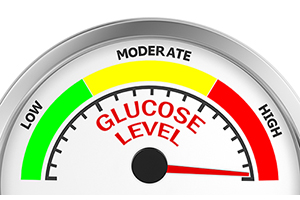By now we’re all well aware of the importance of good blood sugar control. Even when it’s not a matter of lowering out-of-range glucose in outright diabetes—or avoiding inadvertent hypoglycemic episodes resulting from overzealous insulin dosing—evidence is amassing that optimizing blood sugar even when in “normal” non-diabetic ranges confers major benefits.
Borderline elevations in blood sugar are strongly correlated with metabolic syndrome, which is a driver of cardiovascular risk—and are even associated with many cancers.
And studies confirm that hemoglobin A1c—a measure of average blood sugar over the prior 3-4 months—is highly predictive of dementia risk, even among people without diabetes.
Until the advent of Continuous Glucose Monitors (CGMs), it was difficult for people to get accurate, real-time, instantaneous feedback about how they react to medication, supplements, diet, exercise, stress, or even sleep duration. Consider these possible scenarios:
- A non-diabetic person with a borderline hemoglobin A1c—say 5.9—wants to try diet and exercise to optimize their blood sugar but doesn’t want to wait 90-120 days for a repeat hemoglobin A1c to see how well it’s working.
- An individual who’s experiencing what they think are frequent bouts of hypoglycemia (low blood sugar) wants to discover if a pattern emerges in relation to food selection and timing, exercise, sleep, and stress.
- A healthy optimizer is looking for feedback on how they react to specific foods and meals, in effect performing a science fair project on themselves. It’s well known that the GI (Glycemic Index) is subject to high inter-individual variation. For example, one of my patients discovered via CGM that a relatively low GI food, lentils, sent her blood sugar into the stratosphere, while dark chocolate was fine. Plus, foods are often consumed, not singly, but in the context of meals. CGMs are helping some to realize that “naked sugar”—even fruit—causes their blood sugar to soar, but not when consumed with a high-protein, fatty meal.
There’s a growing cadre of non-diabetic individuals who want to study their blood sugar. Until recently, the only self-testing option was frequent finger sticks. But these tests, while now widely available to consumers, are inconvenient and painful. Additionally, you have to test often to detect trends, and then connect the dots to yield a curve of blood sugar values. When you don’t stick, you might be missing meaningful excursions of blood sugar.
Enter CGMs. Several brands are available, including the Dexcom, Medtronics Guardian, Senseonics Eversense and the Freestyle Libre by Abbott, which I’ve been road-testing.
The chief advantage of the CGM is that it’s a wearable that delivers continuous blood sugar readings, offering (theoretically) a 24/7 record of your blood sugar without the need to perform arduous finger sticks.
The Freestyle is applied to the back of your arm with a nicely designed spring-loaded cassette. A small disk with an adhesive extends a painless thin metal probe under your skin and reads your glucose. The disc wirelessly transmits results to a small reader which you periodically swipe to the back of your arm—even through clothing—to obtain your results.
The readout tells you if your blood sugar is steady, rising or falling slowly or rapidly, within or outside a predetermined range, which you can set. It can also be configured to deliver alarms for precipitously rising or falling blood sugar.
You can view graphs of continuous blood sugar readings and spot trends. Say you decide to chuck your very low carb diet and have a breakfast bowl of sugary cereal. Even if you don’t immediately swipe the reader over the sensor disc implanted in your arm, a graph of your morning blood sugar obtained later will reveal a spike.
But alas, there are disadvantages and limitations.
- Inaccuracy: CGMs don’t deliver as precise a reflection of your blood sugar as regular glucoses drawn from your vein, or finger sticks. Remember, CGMs are embedded a couple of millimeters below the surface of the back of your arm, and they’re sampling interstitial fluid, not blood. Therefore, they’re only a rough approximation of your blood sugar. Variations between interstitial glucose and blood glucose are estimated to be around 15% on average. In fact, instruction manuals for CGMs tell you to check your finger sticks occasionally to verify the accuracy of the CGM readout, especially where results don’t seem to make sense. They even flash a warning urging you to fingerstick when levels are soaring or plummeting. In my experience, the Freestyle performed especially inaccurately when sugars ranged low (off by 10 points or more, which could make diagnosing hypoglycemia difficult) or very high (off by as much as 50 points). Additionally, I found there was lots of batch-to-batch variation among the sensors, some closely paralleling finger sticks, others way off. And there’s probably plenty of interindividual variation—some people must have different skin characteristics where the probe goes in.
- Expense: If you’re outright diabetic, you’ll probably get at least partial coverage for your CGM. But if not, or if you have poor insurance coverage, it’ll run you big bucks. The sensors, which last only 2 weeks before they have to be replaced, are expensive. So, too, are the readers, which for some reason must also be swapped out every 90 days (their data can be downloaded to a smartphone, tablet, or computer so it doesn’t get lost).
- Need to swipe: If you don’t swipe, you won’t get a readout. Maybe some of the CGMs can now be configured to give you a continuous Apple Watch readout, but unless you undertake the hack, you’ll be relegated to moving your reader to the back of your arm whenever you want immediate feedback. Of course, the sensor will store up to 8 hours of your previous blood sugar readings, but, say you sleep 9 hours—you’ll lose some data that the device won’t record until you swipe.
- Complicated: They design these devices to be “idiot-proof”, but I must admit it took me several weeks, some trial and error, and many minutes poring over a boring and sometimes confusing manual as well as some online reviews to fully get the hang of it. This might work for well-educated high-functioning optimizers, but for sight-impaired, cognitively-impaired elderly diabetics with diminished tactile sensation in their fingers to tap on a tiny screen—not so much!
- Children and Pregnant Women: Two groups for whom accurate feedback about blood sugar might be of paramount importance—not officially approved. Whether it’s a liability thing, or whether accuracy has not yet been conclusively established I don’t know.
So, bottom line, with the above qualifications, I would say that CGMs are a good option for spotting trends—but not precisely delineating blood sugar. After comparing your CGM reading to a couple of finger sticks, you should be able to mentally recalibrate your CGM readouts to give you a reasonable report card that should inform and reinforce your efforts at diet, exercise and lifestyle modification. It’s fun and revelatory—try it!






